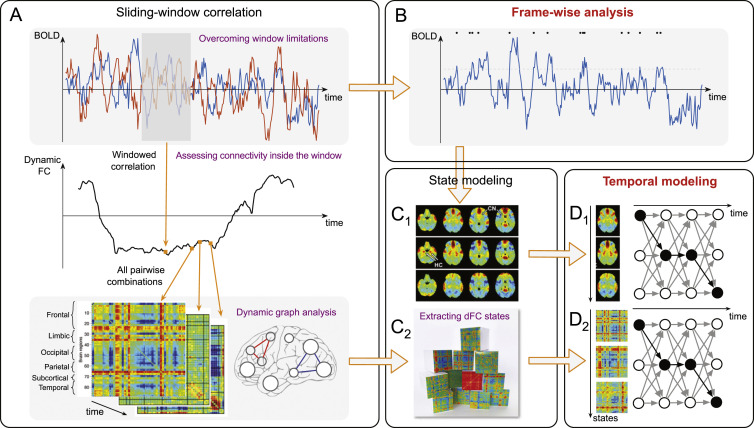Dynamic Functional Connectom
Motivation
2019 summer plan research them~/
Functional Connectivity – Literature review for functional connectivity – Analyze RANN/CR/ADNI non-task and task fMRI data
Interpretable machine learning – Literature review and analysis for anxiety project
Independent component analysis – Group level analysis for EEG and resting state data
Today:
- Soft introduction of (dynamic) functional connectivity (dFC) (Preti, Bolton, and Van De Ville 2017)
- Some example of the most popularly used dFC method
Functional connectivity
Functional connectivity (FC):
the temporal correlation (often measured as a Pearson’s r) in the high amplitude, low-frequency spontaneously generated BOLD signal between voxels (cubic “pixel” in a three-dimensional brain image) or brain regions (Fox & Raichle, 2007)
Why dynamic connectivity?
FC has been shown to fluctuate over time.
Many of existing dFC Mmethods are too complicated:
- Due to the inherent sophistication of methods designed to track temporal fluctuations, it is sometimes difficult to clearly evaluate the underlying hypotheses and validity of a dFC technique in a given setting.
2. Dynamic functional connectivity: Sliding window approach
- fMRI data are preprocessed using preprocessing pipeline (e.g. fsl, spm, afni, etc,) including coregistration, low/high pass filtering, motion correction, slice time correction.
Sliding window approach
Correlation matrix over the sliding windows.
Pearson correlation between pairs of the timecourses is computed over a temporal interval spanned by a rectangular window. This computation is repeated iteratively, shifting the window by a specific step every time, to generate a connectivity timecourse.
Real Data Example
- Using Gorden template, mean time series from 333 ROIs from 26 functional networks are extracted.
- One subject from RANN/CR study, non-task fMRI

FC
- Pearson’s correlation is computed between 333 time series.

Sliding window
- Set the window as 60 secs (equivalent to 30 time points) vs. 120 secs (60 time points)

Limitations
- Too small window: potentially include artifacts
- Too large window: cannot detect temporal dynamics
- Time-frequency approach: allows exploring connectivities in different frequencies, but too much information
Rule of thumb: 30-60s, but the big issue is we ended up computing correlation only using few time points.
Rectangular window: gives same weights within the window; sensitive to outliers
- Solution 1: tapered windows: gives different weights (e.g. less weights to the border), still depends on the preselection of the window size
Solution 2: data-driven window selection (e.g. regression-based change point detection; finding windows preserve local stationariy).
still very ambiguous about how we model this dFC to associated with outcomes of interest, potentially how we can jointly model spatial and temporal patterns of dFC simultaneously. That will be the topic we will expore this summer.
References
Preti, Maria Giulia, Thomas AW Bolton, and Dimitri Van De Ville. 2017. “The Dynamic Functional Connectome: State-of-the-Art and Perspectives.” Neuroimage 160:41–54.

